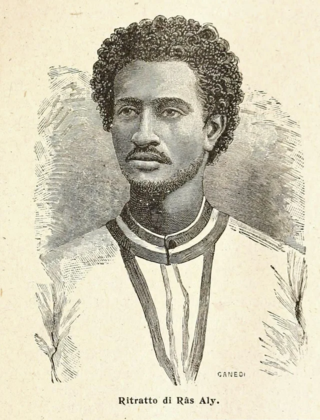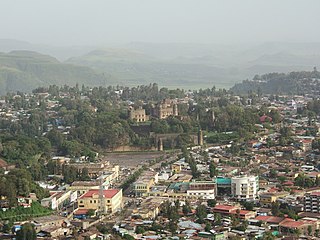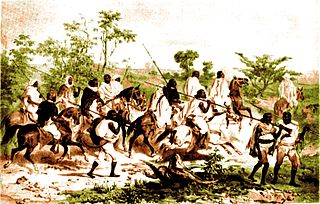Related Research Articles

Taytu Betul was Empress of Ethiopia from 1889 to 1913 and the third wife of Emperor Menelik II. An influential figure in anti-colonial resistance during the late 19th-century Scramble for Africa, she, along with her husband, founded the modern Ethiopian capital Addis Ababa in 1886.
Sahle Dengel was Emperor of Ethiopia intermittently between 1832 and 11 February 1855, towards the end of the Zemene Mesafint. He was largely a figurehead, with real power in the hands of Ras Ali II of Yejju.

Debre Tabor is a town and woreda in north-central Ethiopia. Located in the Debub Gondar Zone of the Amhara Region, about 100 kilometers southeast of Gondar and 50 kilometers east of Lake Tana, this historic town has a latitude and longitude of 11°51′N38°1′E with an elevation of 2,706 metres (8,878 ft) above sea level. The presence of at least 48 springs in the area contributed to the development of Debre Tabor.
Marye of Yejju was a Ras of Begemder and Enderase (regent) of the Emperor of Ethiopia. He was the brother of his predecessor Ras Yimam.
Gugsa of Yejju was a Ras of Begemder, and Inderase (regent) of the Emperor of Ethiopia. According to Nathaniel Pearce, he took the Christian name of Wolde Mikael. He was the son of Mersu Barentu and Kefey, the sister of Ras Aligaz. Both Bahru Zewde and Paul B. Henze consider his reign as Ras and Enderase as the peak of the Yejju Dynasty during the Zemene Mesafint.
Yimam of Yejju was a Ras of Begemder and Enderase (regent) of the Emperor of Ethiopia. He was the son of Gugsa of Yejju.

Ali II of Yejju was Ras of Begemder and the de facto ruler of the Ethiopian Empire. He was a member of a powerful Oromo dynasty known as the Yejju, which ruled much of the Ethiopian Empire during the Zemene Mesafint.

Sabagadis Woldu was a governor of Tigray Province of the Ethiopian Empire from 1822 to 1831. Sabagadis gained some notoriety in the first decade of the 19th century for rebelling a number of times against his overlord, Ras Wolde Selassie. But just before the death of Wolde Selassie it seems that he made up with his master and became one of his loyal lieutenants. Following Wolde Selassie's death in 1816, he defied the authority of Wolde Selassie's son, and became the most powerful warlord in Tigray. Making Adigrat his capital, he ruled Tigray and a small strip of the coastal plains of Eritrea by 1818. His rule also extended to the Eritrean highlands.
The Battle of Debre Abbay, also known as the Battle of Mai Islami, was a conflict between Ras Marye of Yejju, Regent of the Emperor of Ethiopia, and his rival from Tigray, Dejazmach Sabagadis of Agame. Although Ras Marye lost his life in the battle, Dejazmach Sabagadis was defeated and executed by Ras Marye's followers after surrendering.
The Battle of Debre Tabor was a conflict during the Zemene Mesafint in 1842 initiated by Dejazmach Wube Haile Maryam to overthrow Ras Ali II as Regent of the Emperor of Ethiopia and gain control of Ethiopia. This confused battle was won by Ras Ali, but at a steep price, and this victory failed to cement his position as the most powerful nobleman of his time.

The Zemene Mesafint was a period in Ethiopian history between the mid-18th and mid-19th centuries when the country was ruled by a class of regional noblemen and the emperor was merely a figurehead. For the most part, the regional lords were tightly related by marriage and constituted a stable ruling elite that prevailed until the mid 20th century. In short, during the Zemene Mesafint, the Emperors from the Solomonic dynasty were reduced to little more than figureheads confined to the capital city of Gondar.

Semien Province was a historical province of northwest Ethiopia. According to Manoel De Almeida Semien was bordered on the north-east and north by Tigray and Tselemt, on the east and south by Abergele, and on the west by Wegera. Alexander Murray include Wag as part of Semien.
Dejazmach Birru Aligaz was a nobleman of 19th century Ethiopia during the Zemene Mesafint. As Dejazmach, he held the governorships of different districts such as Lasta and Dembiya and was made governor of Dawunt, Wollo in 1842 by Ras Ali II of Yejju. He was the son of Ras Aligaz Abba Seru Gwangul, and had a son called Dejazmach Zegeye.

Wube Haile Maryam of Semien, (1799-1867), also called by his title Dejazmach Wube, Webé; his name is also given in European sources as ‘‘Ubie’’. Wube was one of the major figures of 19th century Ethiopia, during the closing decades of the Zemene Mesafint a period of regional lords vying for power, prestige and territory amid a weakened authority of the emperors.
Menen Liben Amede was Empress consort of Ethiopia by marriage to Emperor Yohannes III in 1840–1841, 1845 and 1850–1851.
Haile Maryam Gebre of Semien, Horse name: Abba Dammana was an early 19th century governor of Semien, Welkait and Wogera. Haile Maryam tried to hold his hereditary possessions in the face of continuous pressure from rival lords during Ethiopia's Zemene Mesafint era. He is remembered as the guardian of Waldeba monastery.
Gebre Tasfa better known as Gebre of Semien was the governor of Semien, Tsegede, Welkait and Wogera during the late 18th and early 19th century in Ethiopia. He held the title of Ras, and had an unusually long reign spanning 44 years during the tumultuous Zemene Mesafint when lords of each province and district continuously fought each other for supremacy. Ras Gebre was the primary backer of his son-in-law Emperor Tekle Giyorgis I claims to the throne.

Welde Giyorgis Aboye was one of the most prominent Ethiopian generals who spearheaded Emperor Menelik's southward expansion at the close of the 19th century. His fame soared after leading the conquest on the Kingdom of Kaffa as a Ras, and was subsequently appointed as provincial governor of that fief by the Emperor. Welde Giyorgis later became the governor of Begemder. A few months before his death, he was elevated to Negus, of Gondar by Empress Zewditu in 1917, as recognition for his role in deposing Lij Iyasu.

This article is about the history of Gondar, a city in Amhara Region of Ethiopia, and previously served as the capital of the Ethiopian Empire from 1632 (at the beginning of Gondarine period to 1855 era.

The Ottoman–Ethiopian border conflict was an undeclared war between the Ottoman province of Egypt and various Ethiopian warlords occurring soon after the Egyptian conquest of Sudan. By the middle of the 19th century, the Ethiopians and Turco-Egyptians faced each other across an undefined and contested border. Muhammad Ali initially entertained the idea of conquering all of Tigray and Amhara, but by the middle of the 19th century Egypt had only limited objectives in Ethiopia, namely to establish its authority over the mineral rich slopes of the Ethiopian peripheral areas.
References
- 1 2 3 4 5 6 7 Uhlig, Siegbert; Bausi, Alessandro; Yimam, Baye; Crummey, Donald; Goldenberg, Gideon, eds. (2003). Encyclopaedia Aethiopica: A-C. p. 561. ISBN 9783447047463. OCLC 722894586. Archived from the original on 2022-10-15.
{{cite book}}:|work=ignored (help) - ↑ Akyeampong, Emmanuel Kwaku; Gates, Henry Louis (2012). Dictionary of African biography vol 1-6. Oxford: Oxford University Press. p. 180-181. ISBN 9780195382075. Archived from the original on 2023-03-12. Retrieved 2023-02-19.
- 1 2 3 4 Rosenfeld, Chris Prouty (1986). "The background of Taytu Betul Hayle Maryam" . Empress Taytu and Menilek II Ethiopia 1883-1910. Ravens Educational & Development Services. pp. 27–31. ISBN 9780932415103.
- ↑ Mordechai, Abir (1968). Ethiopia: the Era of the Princes: The Challenge of Islam and Re-unification of the Christian Empire, 1769-1855. London: Longmans, Green. pp. 32–37. ISBN 9780582645172. OCLC 729977710.
- ↑ Mordechai, Abir (1968). Ethiopia: the Era of the Princes: The Challenge of Islam and Re-unification of the Christian Empire, 1769-1855. London: Longmans, Green. pp. 139–140. ISBN 9780582645172. OCLC 729977710.
- ↑ Rubenson, Sven (1966). King of Kings, Tewodros of Ethiopia. Haile Sellassie I University. pp. 42–43.